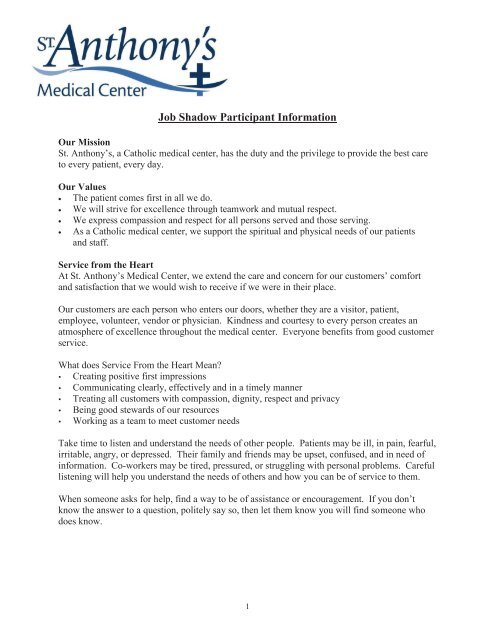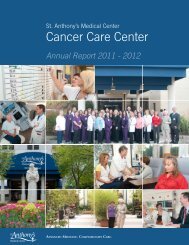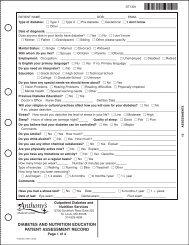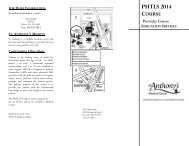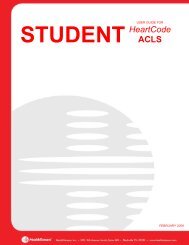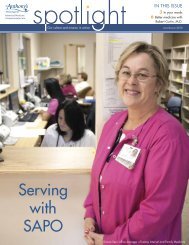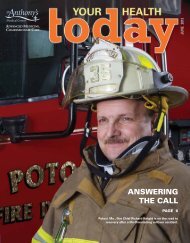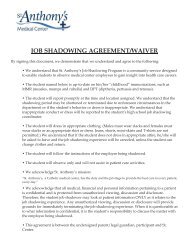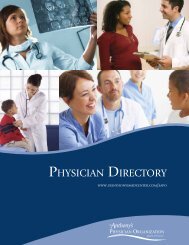Job Shadow Participant Information - St. Anthony's Medical Center
Job Shadow Participant Information - St. Anthony's Medical Center
Job Shadow Participant Information - St. Anthony's Medical Center
You also want an ePaper? Increase the reach of your titles
YUMPU automatically turns print PDFs into web optimized ePapers that Google loves.
<strong>Job</strong> <strong>Shadow</strong> <strong>Participant</strong> <strong>Information</strong><br />
Our Mission<br />
<strong>St</strong>. Anthony’s, a Catholic medical center, has the duty and the privilege to provide the best care<br />
to every patient, every day.<br />
Our Values<br />
The patient comes first in all we do.<br />
We will strive for excellence through teamwork and mutual respect.<br />
We express compassion and respect for all persons served and those serving.<br />
As a Catholic medical center, we support the spiritual and physical needs of our patients<br />
and staff.<br />
Service from the Heart<br />
At <strong>St</strong>. Anthony’s <strong>Medical</strong> <strong>Center</strong>, we extend the care and concern for our customers’ comfort<br />
and satisfaction that we would wish to receive if we were in their place.<br />
Our customers are each person who enters our doors, whether they are a visitor, patient,<br />
employee, volunteer, vendor or physician. Kindness and courtesy to every person creates an<br />
atmosphere of excellence throughout the medical center. Everyone benefits from good customer<br />
service.<br />
What does Service From the Heart Mean<br />
Creating positive first impressions<br />
Communicating clearly, effectively and in a timely manner<br />
Treating all customers with compassion, dignity, respect and privacy<br />
Being good stewards of our resources<br />
Working as a team to meet customer needs<br />
Take time to listen and understand the needs of other people. Patients may be ill, in pain, fearful,<br />
irritable, angry, or depressed. Their family and friends may be upset, confused, and in need of<br />
information. Co-workers may be tired, pressured, or struggling with personal problems. Careful<br />
listening will help you understand the needs of others and how you can be of service to them.<br />
When someone asks for help, find a way to be of assistance or encouragement. If you don’t<br />
know the answer to a question, politely say so, then let them know you will find someone who<br />
does know.<br />
1
Patient Needs<br />
Privacy<br />
Every patient has the right, within the law, to every consideration of personal privacy, including<br />
reasonable visual and auditory privacy, with respect to his/her medical care. The patient has the<br />
right to ask that information about his/her presence at <strong>St</strong>. <strong>Anthony's</strong> <strong>Medical</strong> <strong>Center</strong> not be made<br />
available through our information services.<br />
Confidentiality<br />
The patient has the right, within the law, to expect that all communications and records<br />
(electronic as well as written) pertaining to his/her medical and nursing care be confidentially<br />
treated and read only by individuals directly involved in his/her treatment or the monitoring of its<br />
quality. The patient has the right to expect that these records are only read by other individuals<br />
upon his/her written authorization of that of his/her legally authorized representative.<br />
All patient information is confidential. Problems and confidences of patients, and also of coworkers,<br />
should never be mentioned to anyone who does not have a professional right or need to<br />
be told. Gossip about patients, staff members or about the medical center itself, in addition to<br />
being unethical, could result in serious consequences ranging from unpleasantness to court<br />
action. There may be occasions when it would become your duty to report a matter of this nature<br />
to someone in authority, for the sake of someone’s well-being or safety. Report the information<br />
to your immediate supervisor.<br />
Communications in a <strong>Medical</strong> <strong>Center</strong><br />
1. Never discuss patient information in the cafeteria, on elevators or in public.<br />
2. Upon meeting a person, introduce yourself. Tell the patient who you are and why you are<br />
there.<br />
3. Call the patient by name, but do not use the person’s first name unless requested to do so. If<br />
you don’t know the person’s name, you should ask.<br />
4. SMILE! Smiles convey reassurance, friendship, concern, trust, and humor.<br />
5. Look at the person you are talking to. Good eye contact is important in building human<br />
relationships.<br />
6. Good posture tells people that you are alert and ready to help.<br />
7. Remember the words that convey courtesy and respect: “Please.” “Thank you.” “May I”<br />
8. Understand the impact of body language, facial expressions, and tone of voice, all of which<br />
make a big difference in effective communication.<br />
9. Speak clearly and present ideas in a way, which is easily understood.<br />
10. BE AN ACTIVE LISTENER! Give your undivided attention to the person and don’t<br />
interrupt them. Don’t rush. Show your interest.<br />
2
Infection Prevention and Control<br />
Handwashing is the SINGLE MOST IMPORTANT WAY to STOP THE SPREAD OF<br />
INFECTION!<br />
All employees must wash their hands<br />
Before and after direct patient care.<br />
After removing gloves.<br />
Before eating.<br />
After sneezing or coughing.<br />
After using the restroom.<br />
Beginning and end of each shift.<br />
If soap and water facilities are available, they should be used. If not available, the waterless<br />
alcohol-based hand cleaner may be used.<br />
<strong>St</strong>eps for correct handwashing:<br />
1. Push up long sleeves<br />
2. Wet hands and wrists under running water. Keep fingers pointed downward, water<br />
temperature to comfort.<br />
3. Apply soap and work up a lather. Keep hands below elbow level.<br />
4. Using a friction and rotating motion, wash all surfaces of hands including palms and back of<br />
hands, fingers, and between fingers, and wrists, for at least 15 seconds by the clock.<br />
5. Rinse well under running water, leaving water running.<br />
6. Dry hands with paper towels, working from fingertips to wrists.<br />
7. Turn off water faucet with clean paper towel. Since faucet handle is contaminated, avoid<br />
touching faucet with clean hands.<br />
Do not enter the room of a patient in isolation. An isolation sign will be on the room door when<br />
isolation is in effect.<br />
3
Fire and Emergency Codes<br />
Remain in your assigned area with the staff member and assist staff members until directed to<br />
leave the area or until an “All Clear” is announced.<br />
Problem Description Initial Response Secondary Follow-Up<br />
Response<br />
Bomb Threat<br />
“Code Gray”<br />
Disaster Plan<br />
“Alert <strong>St</strong>atus One”<br />
“Alert <strong>St</strong>atus Two”<br />
Earthquake<br />
Evacuation<br />
Fire<br />
“Mr. Red Burns”<br />
Notification of a<br />
bomb on campus,<br />
usually by an<br />
outside caller.<br />
Announces a<br />
disaster and an<br />
influx of patients<br />
requiring<br />
additional staff and<br />
resources.<br />
Significant<br />
shaking of the<br />
building.<br />
Remaining in area<br />
may be hazardous<br />
to life, health or<br />
safety.<br />
Fire, smoke, or<br />
smell of something<br />
burning.<br />
Obtain as much<br />
information as<br />
possible – where is<br />
the bomb, when<br />
will it go off –<br />
what does it look<br />
like – when was it<br />
placed, etc.<br />
Plan activated by<br />
Administrator or<br />
designee.<br />
Duck and Cover.<br />
Protect yourself by<br />
getting under a<br />
table, moving<br />
away from objects<br />
likely to fall,<br />
protecting head.<br />
Will be notified of<br />
the need to<br />
evacuate.<br />
Evacuate patients<br />
in immediate<br />
danger first, then<br />
ambulatory, then<br />
wheelchair and<br />
then bed-ridden<br />
patients. Take<br />
records if safety<br />
permits.<br />
Rescue those in<br />
immediate danger<br />
(if safe to do so.)<br />
Activate the alarm<br />
(pull manual<br />
alarm.)<br />
Contain the fire<br />
(close doors.)<br />
Extinguish the fire<br />
(if safe to do so.)<br />
Report all<br />
information to<br />
Security<br />
Department<br />
immediately.<br />
According to<br />
individual<br />
department’s role<br />
– outlined in<br />
Disaster<br />
Preparedness Plan<br />
Check yourself for<br />
injuries, survey the<br />
damage nearby<br />
and take<br />
appropriate action.<br />
Report to<br />
designated<br />
assembly area and<br />
account for all<br />
who were in<br />
previous area.<br />
Use an<br />
extinguisher to put<br />
out the fire.<br />
Pull the pin.<br />
Aim the hose.<br />
Squeeze the<br />
handle.<br />
Sweep from side<br />
to side.<br />
Search Teams<br />
inspect the area for<br />
a bomb. Do not<br />
touch it if found.<br />
Report anything<br />
suspicious to the<br />
Security<br />
Department.<br />
Critique of the<br />
medical center’s<br />
response to the<br />
disaster is held<br />
after deactivation<br />
of the plan.<br />
Report problems to<br />
Department<br />
Director or<br />
Supervisor.<br />
Report evacuation<br />
status to Command<br />
Post. Identify any<br />
personnel or<br />
patients<br />
unaccounted for.<br />
Evacuate as<br />
appropriate.<br />
4


